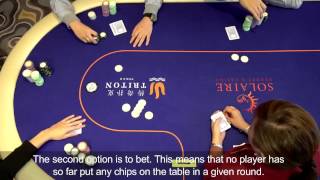Learn Texas Holdem Video Source & Info:
https://www.paulphuapoker.com/
https://www.youtube.com/channel/UCWCUuzDPZKeTgjxeq7RDuOQ
Betting Rules
There are lots of things to learn about Texas Holdem when you start out as a beginner learning the game of poker. Knowing the basics – what the dealer does, what cards are dealt out when, how to carry yourself so you don’t give your hand or emotions away, the value of various hands? (see LINK TO TUTORIAL VIDEOS MENU AND THE BASICS OF POKER MENU for all of that). But until you understand the Texas Holdem betting process you can’t take part properly in the game.
Paul Phua thinks that beginners tend to make similar decisions even in situations that are totally different form each other and demand totally different choices from the poker player. He says: keep evaluating the hand you are in, and if the information you are getting from your opponents, the flop cards and your own cards changes, then you should re-evaluate your chances of winning the hand (https://www.youtube.com/watch?v=Qkyrcn792tQ&t=18s). Similarly Paul Phua thinks you should tailor the size of your bets depending on how many chips both you and your opponents have, how many other players there are in the game, and a whole range of other factors. And to break it down for you, there are five different decisions you can make in the world of betting in Texas Holdem poker.
The first is to fold. That means giving up your interest in the hand: you throw away your cards and you don’t have to put any money in the pot, but you give up on any chance to win the chips that are already in there.
The second option is to bet. The third option is to call.
A fourth scenario is to raise. Say the betting has reached five chips, but you are confident in your cards. So you want to put in five and then add another five to that. This raises the stakes to ten, and means that everyone else who wants to stay in the hand has to up their stake to ten, whether they have bet already or not. You can even raise as far as putting all your chips in – this is called going all in.
The fifth potential option is to check. This means there has not been any action so far in a round of betting. You can check, which means you don’t have to put any chips on the table, but you do stay in the round. However, if someone after you makes a bet, you then have to either match it, or raise it.
Ps – one more thing we don’t want to forget – a word on the “blinds”. These are the forced bets that the two players to the left of the dealer are required to place in the middle of the table, at the start of the hand. This is before they have even seen their cards, and they don’t get those bets back even if they subsequently fold.
Betting in Poker
At the start of every single game of poker, the player to the left of the dealer must post what is called the small blind. That means putting down a pre-agreed number of chips on the table. The person to that player’s left must then post the big blind – an amount precisely double the small blind. Posting blinds is mandatory – even if you then leave the hand without betting.
In games where the position of the dealer doesn’t change – the blinds move round one position to the left, each hand to spread that burden around.
In social games where the position of the dealer does move, the blinds carry on occupying the two positions to the left of whoever deals the cards. The first is to fold. That means giving up your interest in the game. If you haven’t yet bet any chips (or blinds), you can leave the hand cost free. If you have bet already, but now want to leave, you lose those chips. You have in effect, cut your losses. The second option is to bet. This means that no player has so far put any chips on the table in a given round. So you place a certain number of chips in – you are betting. The third circumstance is to call. This means that the betting has reached a certain level – say 5 chips. And you yourself then also bet 5 chips. This is the minimum investment you can make that still allows you to stay in the game. A fourth scenario is to raise. Say the betting has reached 5 chips, but you are confident in your cards. So you want to put in 5 and then add another 5 to that. This raises the stakes to 10, and means that everyone else who wants to stay in the hand has to up their stake to 10, whether they have bet already or not. You can even raise as far as putting all your chips in – this is called going all in. The fifth potential option is to check. This means there has not been any action so far in a round of betting. You can check, which means you don’t have to put any chips on the table, but you do stay in the round. However, if someone after you makes a bet, you then have to either match it, or raise it. So those are the five decisions you can make in Texas Holdem Poker. Fold, bet, call, raise or check.
Source: YouTube








Hello Paul